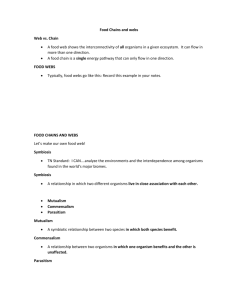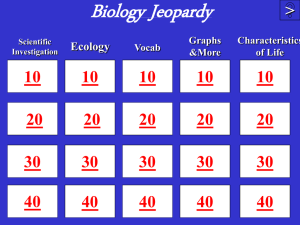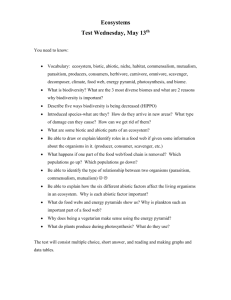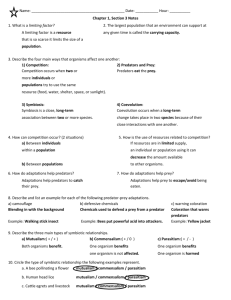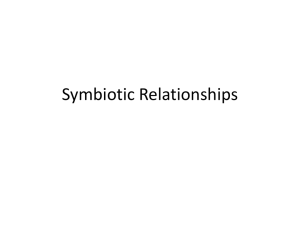S4 C4 PO4
advertisement
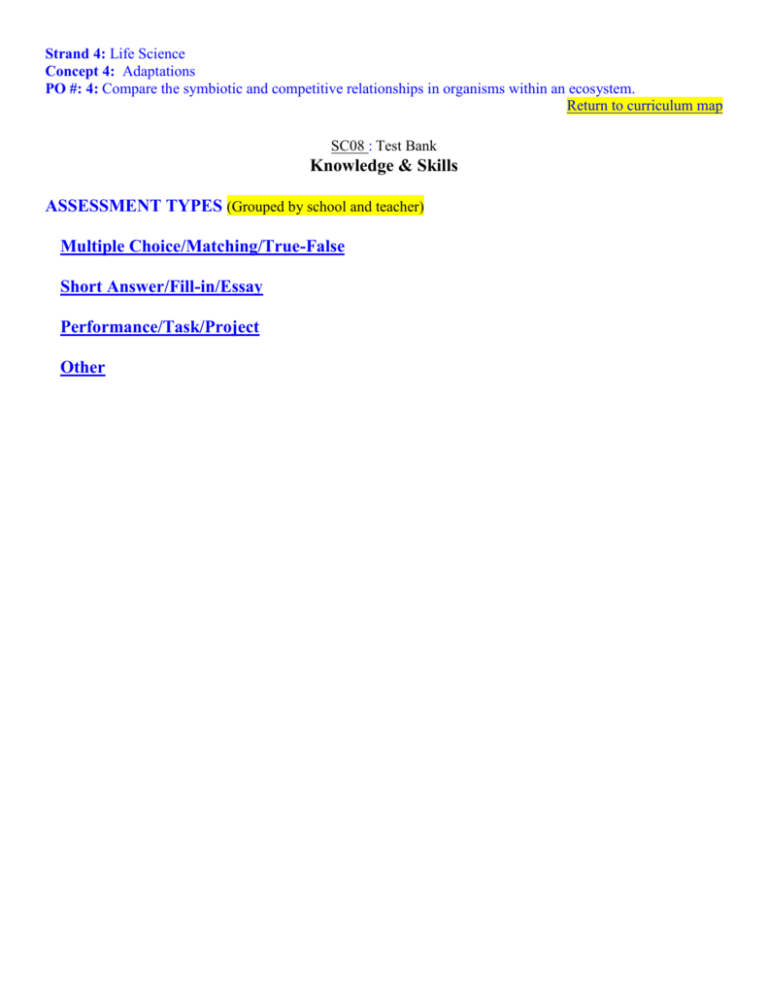
Strand 4: Life Science Concept 4: Adaptations PO #: 4: Compare the symbiotic and competitive relationships in organisms within an ecosystem. Return to curriculum map SC08 : Test Bank Knowledge & Skills ASSESSMENT TYPES (Grouped by school and teacher) Multiple Choice/Matching/True-False Short Answer/Fill-in/Essay Performance/Task/Project Other Strand 4: Life Science Concept 4: Adaptations PO #: 4: Compare the symbiotic and competitive relationships in organisms within an ecosystem. Multiple Choice/Matching/True-False Rhodes – Little Adaptations Vocabulary: Write the letter for the term that correctly matches its definition. A. commensalism B. competition C. mutualism D. parasitism E. predation F. symbiosis 1. A robin builds a nest in a tree without affecting it. 2. A bear kills a fish to eat. 3. Barnacles benefit from a close relationship with another organism. 4. Lungworms live off of the lungs of bighorn sheep causing harm. 5. A fungus provides protection and moisture for algae that it lives with. The algae make food for the fungus. 6. Rams fight over limited living space. Behavioral Interactions: Write letters for the terms being described. A. commensalism B. competition C. mutualism D. parasitism E. predation F. symbiosis 7. The 3 behavioral interactions organisms use to survive when they interact with other organisms. (3 letters) 8. The 3 symbiotic relationships that can exist between organisms. (3 letters) Shepherd – Code 1. A close living relationship between two different types of organisms where at least one benefits is called A. symbiosis B. sharing C. mutation D. cohabitation 2. A symbiotic relationship where one organism benefits and the other is not affected is A. predation B. commensalisms C. parasitism D. mutualism 3. Not having enough food, water, or space for all organisms within a population may result in A. imitation B. competition C. immigration D. hibernation 4. Which of the following would be an example of mutualism? A. two students helping each other with a project B. one student showing another student how to do an assignment C. one student coping another student’s work D. two students working individually on an assignment Strand 4: Life Science Concept 4: Adaptations PO #: 4: Compare the symbiotic and competitive relationships in organisms within an ecosystem. 5. Which of the following would be an example of a parasite/host relationship? A. a cow eating grass B. a lion killing an antelope C. mold growing on bread D. a tick living on a deer Fremont- McGee/Franklin 1. Which symbiotic relationship is represented by the javelina & mesquite, in which the javelina gets food, and the mesquite tree benefits from seed dispersal? (win-win) a. predator-prey c. parasitism b. mutualism d. commensalism 2. Which symbiotic relationship is shown when one organism is benefiting from the relationship and the other neither benefits nor is harmed? Example: When the screech owl lives in the gila woodpecker’s abandoned nest. (win-no one cares) a. competitive c. parasitism b. mutualism d. commensalism 3. Which symbiotic relationship is represented by the mistletoe living in the branches of the palo verde tree? (win-lose) a. competitive c. parasitism b. mutualism d. commensalism Smith – Gratkins 1. Two species live together in a commensalism relationship. What is true about this type of relationship? A. both species benefit B. both species compete with each other C. one species benefits and the other species is harmed D. one species benefits and the other species is not affected 2. What type of relationship involves two species who both benefit? A. commensalism B. mutualism C. parasitism D. benefitism 3. Two species fight for a limited resource. What is the name for type of behavior? A. competition B. commensalism C. parasitism D. symbiosis Strand 4: Life Science Concept 4: Adaptations PO #: 4: Compare the symbiotic and competitive relationships in organisms within an ecosystem. 4. Which is an example of symbiosis? A. two animals compete for food D. two animals help each other find food B. a lion preys on an antelope C. a plant loses its leaves 5. Honeybees move from one flower to another eating flower nectar and pollen. Meanwhile the flowers are getting cross-pollinated. What type of relationship do honeybees and flowers have? A. competitive B. mutualism C. parasitism D. predator-prey 6. A woodpecker bird makes a hole in a pine tree for its nest, harming the tree. What type of relationship do woodpeckers and pine trees have? A. competitive B. mutualism C. parasitism D. predator-prey 7. A clownfish lives among sea anemones. The sea anemones are poisonous to other creatures, but do not harm the clownfish. The clownfish have a safe place to live, and the anemones are not affected. What type of relationship do clownfish and sea anemones have? A. competitive B. commensalism C. parasitism D. predator-prey TOP _________________________________________________________________________________________ Strand 4: Life Science Concept 4: Adaptations PO #: 4: Compare the symbiotic and competitive relationships in organisms within an ecosystem. Short Answer/Fill-in/Essay Rhodes – Little Short Response: Write the words that best complete each statement below. 1. Competition between organisms occurs when ___. 2. Organisms typically will compete for ___ and/or ___. TOP _________________________________________________________________________________________ Strand 4: Life Science Concept 4: Adaptations PO #: 4: Compare the symbiotic and competitive relationships in organisms within an ecosystem. Performance/Task/Project TOP _________________________________________________________________________________________ Strand 4: Life Science Concept 4: Adaptations PO #: 4: Compare the symbiotic and competitive relationships in organisms within an ecosystem. Other TOP _________________________________________________________________________________________
